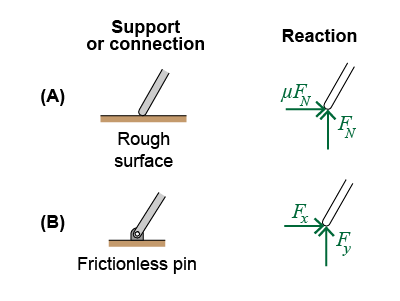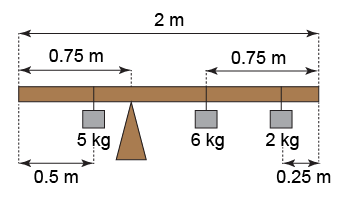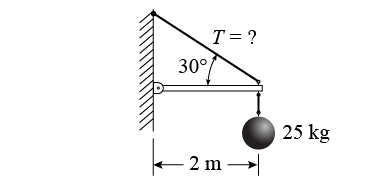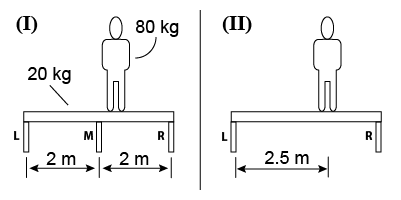- Thick rope may be strong enough to keep a sailboat from breaking free of a dock, even in rough weather. But rope is not used for the handle of a hammer or wrench. Using the language of statics and engineering, explain why.

 Two approaches (A and B) for supporting a tilted beam are shown here. Each offers an upward support force and a force pushing to the right. Suggest one advantage and one disadvantage for each of these two approaches. Two approaches (A and B) for supporting a tilted beam are shown here. Each offers an upward support force and a force pushing to the right. Suggest one advantage and one disadvantage for each of these two approaches.
 A door of width 90 cm is held open by a door stop 55 cm from the hinge. The door stop will exert up to 125 N of force to resist the door from closing. Rather than removing the doorstop, Geoffrey pushes on the end of the door to close it. How much force must he exert on the door to move it? A door of width 90 cm is held open by a door stop 55 cm from the hinge. The door stop will exert up to 125 N of force to resist the door from closing. Rather than removing the doorstop, Geoffrey pushes on the end of the door to close it. How much force must he exert on the door to move it?

 You have a balance beam of length 2 m with negligible mass. The fulcrum is 0.75 m from the left end. There is a 5 kg weight hanging 0.5 m from the left end, a 2 kg weight hanging 0.25 m from the right end, and a 6 kg weight hanging 0.75 m from the right end. You have a spare 5 kg weight. Where would you hang it to balance the beam? You have a balance beam of length 2 m with negligible mass. The fulcrum is 0.75 m from the left end. There is a 5 kg weight hanging 0.5 m from the left end, a 2 kg weight hanging 0.25 m from the right end, and a 6 kg weight hanging 0.75 m from the right end. You have a spare 5 kg weight. Where would you hang it to balance the beam?
| | - You have a very long balance beam. You have placed a 50 kg box 2.1 m to the left of the fulcrum, and a 30 kg box 3.5 m to the right of the fulcrum. Does the balance beam move? Explain using one of Newton’s laws.
- If a 5 kg weight is 3 m from the fulcrum of a lever, how far away from the fulcrum on the other side must you place a 2 kg weight to balance the lever?

- Calculate the tension in the cable that makes a 30° angle as shown in the diagram above.

 In Case I, an 80 kg acrobat stands on a 20 kg, 4-m-long balance beam, which is supported by three equally spaced posts (marked L, M, and R). She stands 2½ m from the left end of the beam. At a later time, in Case II, she returns to the same position, but the middle post is missing. In Case I, an 80 kg acrobat stands on a 20 kg, 4-m-long balance beam, which is supported by three equally spaced posts (marked L, M, and R). She stands 2½ m from the left end of the beam. At a later time, in Case II, she returns to the same position, but the middle post is missing.
- In which case does the L post provide a greater support force, Case I or Case II, or are they equal in both?
- In which case does the R post provide a greater support force, Case I or Case II, or are they equal in both?
- Which case has the largest sum of all of the support forces, Case I or Case II, or are the sum equal?
- In Case I, which post exerts the largest support force, L, M, or R?
- In Case II, which post exerts the largest support force, L or R?
- Now suppose that only two posts hold the beam up at its ends (as in Case II), but the acrobat can stand anywhere along the beam’s length. If a safety factor of 10 is called for, how much compression (in newtons) must either post be able to bear?
|

